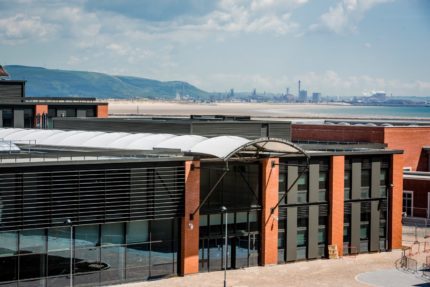Wales has a longstanding history of iron and steelmaking, dating back to the 18th century when the Blaenavon Ironworks were established in 1789. And that connection to the past continues to this day thanks to research partnerships.
The Blaenavon region retains a strong geographical advantage, with a cluster of industry partners and wider supply chains located close to the world-leading research facilities housed within local universities. There are currently around 40 companies and research organisations in the steel and metals sector between Carmarthenshire and Gwent alone. This competitive advantage has generated strong industry-based collaborations, with universities providing research excellence to tackle large-scale, sector-relevant issues.
One such partnership, which was opened in February, is the Steel and Metals Institute (SaMI) at Swansea University which will be home to both university and industry employees. It is the forerunner to the National Steel Innovation Centre (NSIC), which will be funded through the Swansea Bay City Deal and which is due to be operational by 2020. Since late 2016, Tata Steel have been working closely with Swansea University and the Welsh government to develop this new technology centre which will serve the industry’s research and development activities.
This new joint venture, however, is not the start of something completely new. It is simply solidifying a long-standing, successful relationship. Swansea University, which was established at the request of the steel industry in 1920, was founded on the principles of innovation and collaboration.
Over the years, the partnership between Tata Steel in Wales and the university has flourished. Over 120 graduate and doctoral-qualified technologists are currently working in the steel industry in Wales alone, with several now occupying senior roles within Tata Steel, highlighting the symbiotic role between the two organisations as the university provides the business with an essential talent stream of highly qualified steel experts in what is becoming an ageing workforce.
A part of life
Collaborative research projects are also continuously helping to improve the sustainability of the steel business in South Wales. These cover areas such as improving production processes, developing new products, enhancing process efficiency, and extending product lifetimes while creating a positive environmental impact.
Tata Steel and Swansea University are an integral part of life of South Wales. Unsurprisingly, the individuals who work here and live in the surrounding communities, care about the success of the industry. Not only do these major employers strongly influence the prosperity of the region but they are also committed to supporting the community and its social and environmental development. The academic and industry networks also support one another while encouraging and motivating the next generation through STEM initiatives and educational programmes.

As I write this article, I glance from my office window across Swansea Bay and see Tata Steel’s Port Talbot STRIP plant. As the crow flies, the steel plant is situated just six miles from Swansea University’s engineering hub at the Bay Campus. Importantly, it has been demonstrated many times that the most prosperous steel industries in the world have benefited substantially from being closely located to their research organisations.
There are a number of companies that exemplify this strategy, including the world’s largest steel producer, Arcelor Mittal, and Nippon Steel, regarded as one of the most innovative steelmaking companies. Another example of a similar relationship is the Fraunhofer model: the German model of applied research. Thyssenkrupp have attributed much of their success to the close proximity of industry and research organisations which also benefit from one third each of funding from government (national and regional) and industry. The long term collaborative nature of this “cluster” model has delivered a truly impressive manufacturing-led economy within its region.
The steel hub
With such strong geographical advantages and a promising future of government and industry support, we in Wales are in a position to capitalise on this opportunity and lead change in the sector. We now have the capabilities in place to build a successful ecosystem.
By establishing a hub for steel innovation in the South Wales region, we believe that we are on the cusp of creating a solution which will improve the connectivity between academia and industry, while creating a home for a 21st century steel industry.













